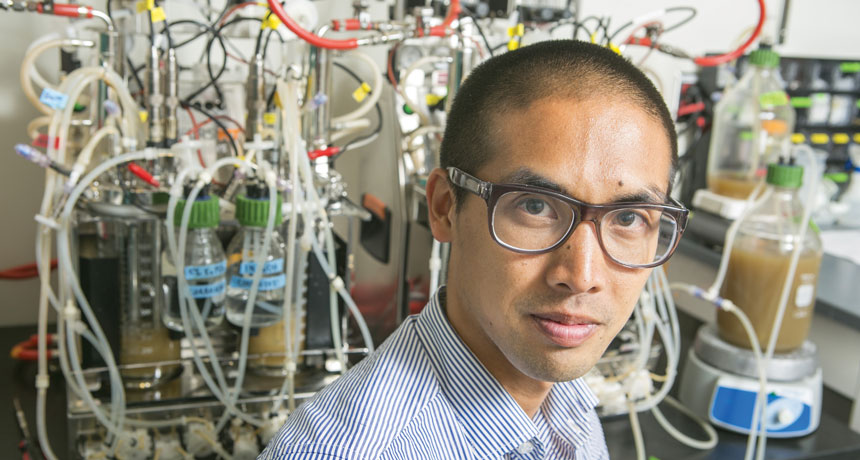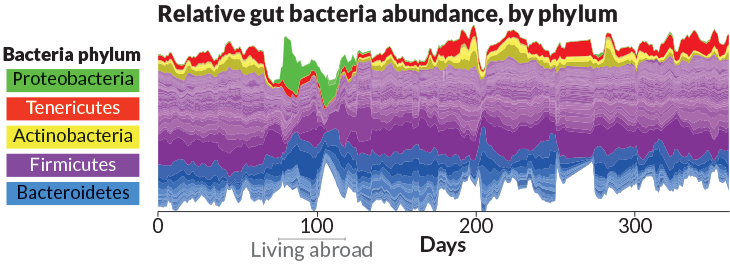
Computational biologist Lawrence David tracked 349 lifestyle measures, in addition to collecting his own saliva and feces.
Leslie Todd/Duke University
Lawrence David, 33
Computational biologist
Duke University

A Jim Carrey movie inspired computational biologist Lawrence David to change the course of his research. As a graduate student, David saw Yes Man, a 2008 film in which Carrey’s character is forced to say yes to all propositions.
David thought the movie’s message about opening yourself to new experiences, even uncomfortable ones, might make science more exciting than it already was. “Only good things would happen if I loosened up and said yes to everything,” he says.
The next day, his graduate mentor at MIT, Eric Alm, was talking about the brand-new science of the human microbiome, the collection of bacteria, viruses and other microscopic organisms inhabiting the human body. What someone ought to do, Alm suggested, is sample a person’s feces every day for a year to see whether the microbiome changes. “I had just seen the movie, so I said, ‘Well, I guess I have to say yes now,’ ” David recalls.
David took Alm’s suggestion a step further by chronicling his own microbiome, collecting his feces every day in “plastic hats that look like something the Flying Nun would wear.” He washed his mouth with a chemical solution and spit into a tube to harvest mouth bacteria, popping all the samples into his refrigerator or freezer until he could get them to the lab. He customized an iPhone diary app so he and Alm, who joined the study, could track 349 different health and lifestyle measures, which included the timing and consistency of bowel movements, sleep quality and duration, blood pressure, weight, vitamin use and mood. They noted, in detail, the foods they ate, symptoms of any illnesses and medications used to treat those illnesses. By the end of the year, David had “10,000 measurements of how two people lived their lives.”
David, now 33 and at Duke University, regularly opens himself to new scientific challenges, though they aren’t always quite so personal. Before finishing his degree at MIT, he had already initiated one new field of research and delved into several others outside his expertise.
Awards committees and granting organizations have taken note. David has won the Beckman Young Investigator award and the Searle Scholars award, which support cutting-edge work by young scientists. Fresh out of graduate school, he became a junior fellow at Harvard, where he led his own research.
“He has an ability to see what the problem is and just get it done in the most straightforward way possible,” Alm says.
David spent most of his graduate student years in Alm’s lab writing and running computer code that calculated the ancient birth dates of genes, reproducing the most likely evolutionary histories of gene families and predicting capabilities of ancient microbes. Alone that would have been a nice contribution; many researchers thought untangling those relationships would be too computationally complex, Alm says.
But to get the full picture, David had to expand into other fields, working with geologists and geochemists to determine whether his predictions made sense in light of Earth’s geologic history. In a study that birthed a new field by marrying geochemistry and genetics, he and colleagues discovered that genes encoding oxygen-producing proteins appeared hundreds of thousands of years before oxygen began accumulating in early Earth’s atmosphere (SN Online: 12/21/10). For a study published in Science in 2008, he also delved into ecology, investigating how ocean microbes evolve into separate species without the physical boundaries that would keep them from mixing.
Population flux
The personal microbiome challenge was an unprecedented look at how friendly bacteria change over time and with lifestyle and dietary choices. Long known to play an important role in digestion, the gut microbiome has recently been implicated in health conditions including heart disease, obesity and asthma, and may even influence behavior (SN: 4/2/16, p. 23). Many people have suggested that humans and their microbes are so interdependent, they should be considered composite organisms (SN: 1/11/14, p. 14).
David, Alm and colleagues presented the results of their study in 2014 in Genome Biology. They found that the gut microbiome remains stable for months, but some events, such as travel, illness or changing the fiber content of the diet, can rapidly change the mix of gut microbes. Only a handful of studies have ever been done on this fine of a timescale, Alm says.
A project that would have made others hold their noses “might have been the most enjoyable thing I’ve done in science,” David says. The microbiome analysis relied on computer tools similar to ones he had used as an undergraduate researcher at Columbia University, making it intellectually satisfying.
But the real appeal was how others responded to the work. “People were immediately captivated by the work, and would start to tell me about their own gastrointestinal histories, odd things they had eaten and how that affected the bacteria in their gut,” David says. People sometimes asked his advice on what to eat to keep their gut microbiomes healthy, a question for which he didn’t have a clear answer. “There’s an irony to this,” he says. His voice drops to a whisper as he confesses: “I love junk food…. I shouldn’t be a poster child.”
Hooked on the microbiome, David began studying other people’s bacteria with the help of Peter Turnbaugh, a microbiologist then at Harvard and now at the University of California, San Francisco. By intentionally manipulating people’s diets, the researchers found that it takes only a day for a major dietary change, such as a meat-eater going vegetarian, to shift the composition of gut bacteria. The results, which surprised researchers who had thought such shifts would be more gradual, were reported in Nature in 2013 (SN Online: 12/11/13).
When he arrived at Duke in 2013 to start his own lab, David had a strong track record of developing computational tools to analyze complex datasets, says John Rawls, a microbiome researcher at Duke. But what makes David special isn’t just that he’s a good computer coder. “What sets him apart is his ability to incorporate technology and concepts from engineering into his work,” Rawls says.
Most labs that study the microbiome start with animal studies. But David began with a machine — an artificial gut for growing and manipulating intestinal microbes donated by human volunteers. The contraption consists of multiple growth chambers bristling with plastic tubes. Inside, what David has called “the world’s nastiest slurry” (a fecal sample from a donor) ferments in conditions similar to those in the intestines. One tube feeds into what looks like a dome hair dryer from a beauty salon. That’s a concession to neighboring researchers who complained about the pungent smell.
When graduate student Rachael Bloom joined the lab, David persuaded her to try a completely different way of growing bacteria from feces, designing chips with channels that separate out bacteria into microscopic drops of liquid. In just a few minutes, Bloom can create what are essentially thousands of tiny petri dishes, each with a single bacterium. Neither student nor mentor had any experience with the “microfluidics” technique, but David encouraged Bloom to try, and even be open to failure. “In retrospect, that could be really dangerous,” says Bloom, “but I have learned so much.”
David’s aptitude for engineering shows up at home, too. To keep his two preschool children from getting up too early, David rigged LED lights on a timer. The kids have to wait for the lights to go off before getting out of bed. His wife, a psychiatrist, reinforces the good behavior with a treat.
David says he “tends to be an optimist,” and just assumes his team will find a way over or around any hurdle. “He’s very adventurous. He’s very creative,” says Turnbaugh. “He’s one of the great people in microbiome research who is thinking outside the box and not just following a template.”
David has a simple explanation for why he continues to say yes to projects outside his comfort zone: “I’m easily fascinated.”
Editor’s note: This story was updated to correct the profession of Lawrence David’s wife. She is a psychiatrist not a psychologist.








